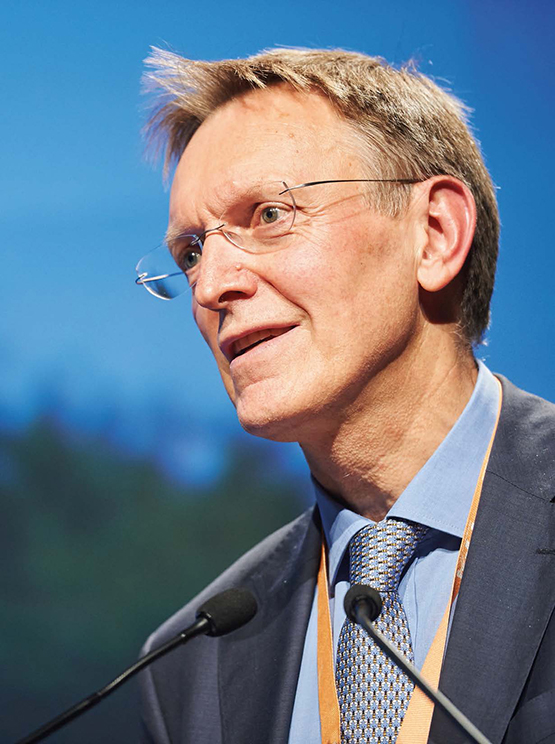 |
|
Janez Potocnik – Forum for the Future of Agriculture, Brussels 2016
|
Adopted by the European Parliament on April 18th 2018 and approved by the European Council on May 21st, the Circular Economy Package has never been so close to becoming a law. How important is this package and what next on the political agenda? We asked the former European Commissioner for the Environment and initiator of the Circular Economy Package back in 2010, Janez Poto�nik, these very questions.
Could you give us the genesis of the Circular economy package?
“Back in 2010 ideas on the environment were split into two areas: one was climate change, the other was the rest of the environment. Although at first glance this split looked quite unnatural, operationally it proved to be quite useful. At the time, climate change was the centre of attention, while the rest of the environment wasn’t addressed as much. This is why, when I started my mandate as European Commissioner of the Environment in 2010, I needed to find a new narrative that would help solve some of the most problematic environmental issues. I chose to highlight the link between the environment and economic activities and then to persuade people that, in essence, if you look at it the right way, the environment portfolio was probably the strongest economic portfolio of the European Commission.
On this basis, we started with an initiative on resource efficiency. We established the ‘resource efficiency roundtable’ and, later on, adopted a ‘resource efficiency roadmap’ which was actually the first step in the direction of the Circular Economy Package.
While this initiative was evolving pretty well, during the second part of my mandate we had to review the Waste Legislation Package. We used that moment to try to change the story of waste management, in order to see waste not as a problem but rather as a solution for some economic challenges in Europe, including competitiveness.”
What have the main obstacles to the Circular Economy Package been and how were they overcome?
“The main obstacle was the misunderstanding that environmental measures have more or less negative consequences on the economy. A misunderstanding that is based on an incorrect assumption. Of course, any environmental measure increases costs, but these costs already exist, and we’ve simply been denying their existence. Somehow, these costs are not paid for by the producers and the consumers of goods. They are shifted onto the health system or, which is even more common, to the next generation because the next generation, as you know, cannot complain.
Overcoming this obstacle required a lot of hard work, a lot of meetings at all levels. In particular, it required generating a lot of evidence that demonstrates how environmental measures are good, not only for wellbeing and the environment, but also for the economy.”
The Circular Economy Package has gained a lot of support from the European Parliament and from various stakeholders. How has such a consensus been achieved?
“From the moment the resource efficiency roundtable was established, we worked consistently to build a consensus. We brought together ten or so business leaders, such as Paul Polman from Unilever, already actively involved in the circular economy. I brought some of my colleagues from the Commission, including those dealing with economic issues, and some very active European members of parliament. We also brought researchers from academic circles, representatives of NGOs, and leading representatives from trade unions and consumer associations at the EU level. So, practically, everybody was sitting at the table. The participants nominated sherpas (personal representatives of heads of state that prepare international summits), worked very hard for some two years, and created a proposal that I translated into legal actions or other political proposals which were included in the Circular Economy Package.
Later on, when the new Commission withdrew the Circular Economy Package, it was quite logical that there were some intense protests because all those participants felt ownership of the circular economy and believed in its development in Europe.”
The Circular economy package is ambitious, but is it ambitious enough?
“First, we need to understand the essence behind the Circular Economy Package. Our existing economic model has proven to be socially, environmentally and even economically unsustainable. It is responsible for unequal distribution of wealth, biodiversity loss, climate change, and economic crisis. In addition, we are living in a world that is characterised by tightly knit human social-ecological systems on a planetary level. We are more interconnected and interdependent than ever and, for this reason, our individual and collective responsibility has increased enormously. On top of this, we are facing new 21st century challenges, including population growth, increase in per capita consumption, ageing population, digitalisation and robotisation, that we simply cannot ignore. A change in our economic model is necessary and, basically unavoidable.
It is important that we understand that the circular economy is a very efficient instrument for the transition to this unavoidable new economic model and it should be embraced by all. Circular economy should also be seen as a solution for European Union competitiveness because the European Union is very import dependant when it comes to various resources.
Of course, it is no secret that this package should go faster and would need to be broader but, undoubtedly, it is an important step. It is also clear to me that the next step is needed and that there is no time to lose.”
The circular economy will not only save resources but also create jobs. Can job creation become a major driver for the transition towards a circular economy?
“Certainly, economic growth that supports job creation could be an important driver. Of course, to be frank, it is easier to prove the existence of a positive correlation of circular economy with economic growth than with employment. However, what is essential is that the development of a new economic model, today localised in some regions like Europe or China, moves to a more global level. It is essential that we remove some of the barriers, such as market barriers, to avoid the danger of becoming, or being viewed as, another Western model which protects our own interests. It is essential that employment moves to the centre of the circular economy package. As we further develop the circular economy model, we need to implement solutions that employ more people, that create local jobs and jobs that cannot be displaced.”
What should the Commission’s next priorities be?
“First, let’s see what needs to be done, regardless of who should do it, whether it be the Commission or on a more global or local level. We need to enforce the circular economy synergies with the social dimension, with climate change, with bioeconomics (which is also becoming ever more important), and with cities, because we have to be aware that the next wave of urban development will be practically over in the next fifty years. We also need to work on how to retain value in the circular economy because, sometimes, we are focusing far too much on the quantity of waste but not on the value we are retaining, and this value is an important economic driver for the adoption of the circular economy.
If you look at it from the point of view of the Commission, I believe that the focus should be on: the implementation of the Plastics Package, which I think is an important package; on the design of products, with the Eco-Design Directive; and on removing the barriers to new business models, such as product as a service and the extended producer responsibility models. The Commission should also work on topics, where it has less power but it should absolutely help, such as market incentives, which have kept us stuck in our existing economic model. The Commission should help to change the signals sent to the market, enforce a better valuation of natural capital, update the tax structure and leverage public procurement. Practically, there is a lot of work still ahead of us and we will have to work systematically all across the board.”
Having adopted the Circular economy package, can Europe lead the global economy towards a more circular economy?
“I think that not only it can, but basically it should. I would like to explain why. Today there is a serious call for redefining sovereignty because many of our problems, such as the change of our economic model, can only be solved at a global level. An example of redefinition of sovereignty is the Paris Agreement on climate change where we all agreed to introduce solutions in the best possible way to protect our environment.
Why is the European Union important for that? Because, seventy years ago, the European Union redefined sovereignty to achieve one single objective: avoid conflicts and wars on European soil. It encountered quite some problems but, in the end, it achieved its objective. Furthermore, all the challenges that we face today are pretty much the same as those Europe was facing seventy years ago.
Basically, I believe that to redesign sovereignty, on top of the three conventions which already exist since 1992, namely the Convention on Climate Change, the Convention on Biological Diversity (CBD) and the Convention to Combat Desertification (CCD), there might be a need for another convention which we could call ‘Natural Resource Management Convention.’ This new convention would basically connect the three existing ones, it would link the stories of biodiversity and climate change with the one of a new economic model, and it would create the required conditions and remove barriers, such as market barriers, which are currently preventing us from moving forward on a global level.”
Now that the Circular Economy Package is about to become a law, how can the circular economy remain at the top of the political agenda?
“I am absolutely convinced that the circular economy should remain at the top of the political agenda. It is essential for a transition to a more responsible and sustainable economy. It is an extremely important part of the answer to the fight against climate change. It is simply not enough to focus on energy and the supply side. We also need to look at the demand side: production and consumption models, the consumption of other resources like land, water and particular materials which are not appropriately managed. Inefficient resource management could become another CO2 emission driver and we would simply not solve the climate story properly. Finally, circular economy is an important answer, if not the answer, to the competitiveness of the European Union’s economy which, as I already mentioned, is extremely import-dependent. A politician who does not understand this should not be in politics.”


